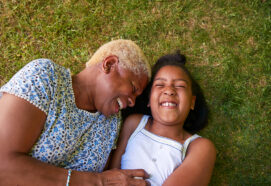In this podcast series ‘Autism, a parents guide’ Dr. Ann Ozsivadjian with special guest Dr. Marianna Murin discusses autism with freelance journalist Jo Carlowe.
Episode 3 looks at ‘How autism presents differently in girls’, amongst the discussion is the prevalence of autism in girls and the challenges faced. Whether girls get treated differently to boys and what interventions and support are most beneficial.
We are delighted to that this podcast series for parents is supported by the Autism Diagnostic Practice at Clinical Partners. Working nationwide with only the most experienced consultants, Clinical Partners ensures you get the best ASD diagnosis and help tailored specifically to your child, as fast as possible. Discover more.
You can listen to this podcast directly on our website or on the following platforms; SoundCloud, iTunes, Spotify, CastBox, Deezer, Google Podcasts and Radio.com (not available in the EU).
Other Episodes in The Series
Episode 1 ‘Identifying Autism – getting the right diagnosis’ with Dr. Ann Ozsivadjian.
Episode 3 ‘How autism presents differently in girls’ with Dr. Ann Ozsivadjian and Dr. Marianna Murin
Episode 5 ‘Recognising mental health issues’ with Dr. Ann Ozsivadjian
Episode 6 ‘Food Sensitivities and Proclivities’ with Dr. Vicki Ford
Episode 7 ‘Tailoring Support CBT and Mindfulness’
Episode 8 ‘Challenging Behaviour and Demand Avoidance’
Transcript
Intro: This podcast is brought to you by The Association for Child and Adolescent Mental Health, ACAMH for short. You can find more podcasts and other resources on our website, www.ACAMH.org and follow us on social media by searching ACAMH.
Interviewer: Hello. I’m Jo Carlowe, a freelance journalist with a specialism in psychology. Welcome to the latest instalment of Autism, A Parent’s Guide.
This podcast series focuses on autism spectrum disorder and is designed to help families and carers. It is produced by the mental health charity The Association for Child and Adolescent Mental Health, ACAMH in short, in partnership with Clinical Partners. Search for Clinical Partners, Autism, or visit www.clinical-partners.co.uk.
For more information about ACAMH, visit www.ACAMH.org. The focus of today’s discussion is how autism presents differently in girls. Amongst the discussion points is the prevalence of autism in girls and challenges faced. Whether girls get treated differently to boys and what interventions and support are most beneficial.
Today I’m interviewing. Dr. Ann Ozsivadijan, independent clinical psychologist, researcher at King’s College London and honorary principal clinical psychologist at the Evelina London Children’s Hospital, and chartered clinical psychologist, Marianna Murin, who is the founder of Autism Spectrum Directions Limited.
Ann and Marianna, welcome. Can you start by introducing yourselves?
Dr. Ann Ozsivadijan: Hello. Yes. I’m Ann Ozsivadijan. I’m a Principal Clinical Psychologist in independent practice. I’m also an Honorary Clinical Psychologist at the Evelina London Children’s Hospital where I worked in the complex neurodevelopmental disorders team for 16 years. I’m also an honorary researcher at King’s College London.
Marianna Murin: Hi, I’m Marianna Murin. I’m a Childhood Clinical Psychologist in independent practice and I also work at Anna Freud Centre and UCL as a Senior Clinical Tutor.
Interviewer: There’s a general perception that ASD is something that mostly affects boys but today we’re focusing on girls. What is the prevalence of ASD in girls and how does this compare to boys?
Marianna Murin: This is indeed very much the case. Autism spectrum has been, for decades, perceived as a condition that we predominantly see in males. Traditionally, prevalence studies quoted estimates that autism spectrum is four times more prevalent in boys than girls. However, this estimate was based on children who already had an existing diagnosis of autism spectrum.
A recent meta-analysis of prevalence studies conducted by Rachel Loomes, Laura Hull and Will Mandy in 2017, which was based on screening the samples from the whole population, i.e., not just the children who were already identified as having ASD, indicated that in fact, prevalence rates are closer to three two one. That is three boys to one girl. The study was very important as it clearly indicated what we’ve long suspected, clinically, that there appears to be a diagnostic gender bias. Meaning that girls who meet criteria for autism spectrum are at disproportionate risk of not receiving a clinical diagnosis and are currently being missed.
Interviewer: Because of this misperception of autism being an issue for boys rather than girls, is it harder to get a diagnosis of ASD for girls?
Marianna Murin: Yes, absolutely. There are three clear messages we are seeing both in clinical practice and these are also supported by research studies. Firstly, as we mentioned before, research is showing us that girls are currently being missed, which means that they are missing out on important support services.
Secondly, girls are identified later than boys, as indicated by a number of studies, which again, raises concerns that girls miss out on early intervention and support.
Thirdly, which is something we see in clinical practice most often, is that girls tend to meet, to present with additional problems such as mental health problems, including anxiety, depression or learning difficulties to raise concerns about potential diagnosis than boys.
So, the answer to your question is yes, absolutely. There is clear research, as well as clinical evidence, that it is harder to get a diagnosis for girls on the autism spectrum and that it has implications on the support they receive
Interviewer: Does ASD manifest differently in girls or is it exactly the same as for boys?
Marianna Murin: This is a very important question and it is one of the key issues we are trying to raise awareness of. In terms of what we know about differences between the female and male presentation of autism spectrum, there are four key areas of difference.
The first important area is area of social motivation. There are very interesting findings that came out of the series of research studies conducted by Felicity Sedgewick, Vivian Hill and Liz Pellicano in 2015, which demonstrated that whilst boys with autism spectrum tend to have different friendships to non-autistic boys and tend to be, in general, less socially motivated to form social relationships, girls with autism spectrum tend to have similar motivation to form social relationships as their non-autistic peers. However, they experience high levels of conflict in friendships and found large groups harder to deal with.
Secondly, we know that strong interest in preoccupations are an important feature and one of the key diagnostic features for autism spectrum. The difference we see between the girls and boys is that whilst circumscribed interns interest for boys tended to be in the areas more typically associated with autism spectrum, such as Mechanics. For girls, it tended to be mostly related to more socially motivated preoccupations such as interest in a particular band and following them on YouTube and all other aspects of social media, to intense interest in religions, animals, movies and pop culture. One of the young girls I’ve worked with was so focused on trying to find her identity that she read and reread the International Diagnostic Manual of Mental Health Problems to the point that she could quote all diagnostic features of autism spectrum, personality disorders or any other condition.
Also, girls tend to present with fewer of the repetitive or stereotyped behaviours such as flapping or spinning. Thirdly, there’s an issue of masculine camouflaging, which is a term frequently used by people on the autism spectrum referring to hiding of autistic behaviours such as systemic and explicitly using more socially acceptable behaviours. Whilst we know that many people on the autism spectrum feel under pressure to master autistic features in order to fit in and in order to avoid discrimination or social isolation, most of these founded females on the autism spectrum camouflage more than males. Sarah Hendrix, a strong autism advocate, ASD consultant, and writer, who has lay-diagnosed ASD herself, always says females with autism spectrum spend the first 20 years of their lives hiding their autism and the next 20 years of their lives trying to convince people that they really have it. Whilst masking or what is often referred to as camouflaging can be a very adaptive strategy in some contexts, such as job interviews, it can take its toll on wellbeing. In many cases, we hear that females with autism spectrum reporting exhaustion and fatigue as one of the most frequent consequences of masking and camouflaging.
Another frequently reported consequence is increased anxiety and stress about getting it right, as well as low mood, depression, loneliness or loss of identity. The fourth critical difference found is that females with autism spectrum are much more likely to have internalizing disorders such as anxiety and depression than boys, who are more likely to have externalising disorders like behavioural difficulties, in general.
Interviewer: What do we know about the causes of ASD in girls? What does the research tell us?
Dr. Ann Ozsivadijan: There is no evidence to suggest that causes of autism in girls is any different to boys. We don’t really know enough about the causes of autism in either gender, in fact. We know that there are a number of genetic influences and sometimes, medical problems, which can cause brain abnormalities, giving rise to autism. We certainly do know that autism is not caused by parenting or vaccinations, in either gender.
Interviewer: Greta Thunberg, the schoolgirl climate activist, has spoken about her Asperger’s Syndrome diagnosis after she was criticised over the condition, saying it makes her different but that she considers it a superpower. What do you think is the effect of such a high-profile debate with the media about ASD and girls?
Marianna Murin: We are the biggest fans of such strong positive role models promoting neurodiversity. Neurodiversity is a biological fact. It’s a natural variation in cognitive styles in the very same way, if you see variation in height or any other profile of natural strengths and difficulties. There is very little doubt that, throughout history, people with autism spectrum have contributed significantly to the world of science, technology, arts or any other walk of life.
Role models like Greta clearly promote this message in a modern society. The progress has always been achieved, thanks to diversity and cognitive styles. To achieve progress, we need people who are creative and have original thought. We need people who are perfectionists and finishers, just as much as we need people who are into technology or into humanities. Autism spectrum brings about some incredible strengths. Thinking outside of the box, having original thinking alongside of preoccupations, can be key ingredients for success. So Greta is not only a brilliant role model, increasing awareness of autism spectrum and autism spectrum in girls. She is also the most brilliant role model for the importance of embracing neurodiversity.
Dr. Ann Ozsivadijan: Yes, Greta describes autism as a gift. The ability to think differently and outside of the box and having worked with people on the spectrum for over 20 years, I would definitely agree. However, sometimes those gifts and the ability to see things differently can have a flip side and can lead to emotional problems. So for example, cognitive inflexibility can be extremely useful, that drive to complete something, come what may, a single-mindedness which means you may become expert in something. But this can also lead, the inflexibility that is, can also lead to difficulties in interactions. For example, being inflexible about seeing someone else’s point of view or becoming very upset at the imperfections of the world or people and the world is such an imperfect place. Thinking very deeply can be an asset. It can be such an asset, in fact, but it can also be associated with a negative thinking that can cause depression. So, while we fully advocate the positive messages about neurodiversity, it’s important to remember the vulnerabilities that many people with neurodiverse presentations, not just autism, in fact, experience.
Interviewer: I’m wondering if girls with ASD get treated differently to boys. Perhaps there’s a sense of oh, they’ll grow out of it or less tolerance. Is this something you have found?
Marianna Murin: Yes, we do hear many girls and young women who feel under a lot of pressure to conform and fit into the societal expectations. However, perhaps the main difference is related to what we mentioned earlier, as girls tend to mask their autistic features a lot more and they tend to internalise more. People generally tend to underestimate the levels of difficulties girls are experiencing. What we encounter very frequently in our clinical practice is school professionals who, irrespective of how dedicated they are, might report that a particular girl is not experiencing any difficulties at school. Although, in reality, she might be experiencing severe distress from sensory overload, social isolation or bullying but she’s not expressing these, verbally or conveying them, non-verbally. Girls are much less likely to receive support than boys, who are more likely to present with externalising difficulties which, by their nature, tend to attract more attention and more support.
Interviewer: Recently, Greta Thunberg’s father, in an interview on BBC Radio 4, revealed that prior to taking up her campaigning role, Greta had depression and had refused to eat. How closely are issues of this sort associated with ASD?
Dr. Ann Ozsivadijan: Yes. So, depression, anxiety and eating difficulties such as ARFID, which is Avoidant and Restrictive Food Intake Disorder, are very commonly associated with autism and potentially, more common in girls than boys. In fact, the rates are so much higher in autism, that there’s a lot of research looking into whether there are specific things about autism that lead to, for example, depression or eating problems.
So for example, certain thinking styles such as black and white thinking, have long been associated with depression, but we also know that these are very characteristic of autism. Cognitive inflexibility is also associated with anxiety, possibly depression as well and certainly, eating disorders. It’s also a hallmark feature of autism. In fact, we’re hoping to publish some data looking at this, shortly. What we don’t know is whether there are any gender differences in these pathways. So, for girls though, as mentioned, social camouflaging can lead to mental health problems due to the strain of masking, of fitting in. Although, equally, more and more, we’re recognising that boys can mask, too.
Also, eating disorders tend to be more common in autism spectrum and possibly, more so in girls, to some degree because of more typical intense interests. They might seem typical, but for example, conforming to certain body image expectations and then, factoring in maybe, an inflexibility or hyperfocus on certain things such as calorie intake. These things, together, can increase the risk of eating disorders in autism spectrum. Certainly, we do know that there is a greatly increased likelihood of autism, both diagnosed and undiagnosed, in people within eating disorder services. So, the other way around, as it were.
Interviewer: What interventions seem to be most beneficial for girls with ASD?
Dr. Ann Ozsivadijan: There’s no evidence, currently, of any gender differences in response to different treatment options. Although, to be fair, the only evidence we really have for psychological treatment in ASD is regarding cognitive behaviour therapy, little bit of mindfulness. None of those studies, to my knowledge, have looked at gender response to treatment. So, we just don’t know yet.
Interviewer: Right. When thinking about ASD in girls, what are the key issues that girls and their parents are seeking support for?
Dr. Ann Ozsivadijan: So, Marianna and I run workshops for girls and young women on the spectrum and although, we prepare some discussion points in advance, the groups are very much client-led. The topics that come up most often include camouflaging, perhaps not surprisingly, and also, sensory sensitivities, which can cause quite a lot of discomfort. Anxiety management is also a very common theme.
We also prepare a session on the differences in presentation between girls and boys on the spectrum, which can be really helpful for girls to understand why some of the literature, which until recently really focused much more on typical male presentations, might not seem that relevant and might not have seemed that relevant to them. As girls may have been diagnosed much later in childhood or adolescence, there’s often a lot of discussion about what it was like before receiving a diagnosis and about feeling different but not knowing why. Importantly, about people around them not knowing why they were a bit different.
So, this is something we discuss quite commonly in the groups and the feedback that we get every time, as well, from the groups, is that one of the main benefits is actually meeting other people who they can relate to, who have been through similar experiences when hitherto, they may feel quite isolated. I think we’ve been really quite struck by that on a number of occasions.
Interviewer: For parents of autistic daughters, what are the main takeaways? How can they best support their children?
Dr. Ann Ozsivadijan: Well one way is to seek an assessment. So, if your gut feeling is that there is something different about your daughter’s development, even if other people such as GP’s or school staff are uncertain, for example, trust your gut and avoid delays in diagnosis if you think it’s the right time. But it is important to get the timing right, though because as differences in girl’s presentations, sometimes they don’t become apparent until quite later. So, one doesn’t want to assess too early and then arrive at false negative as well. But if those differences are sustained, then it’s important to get them properly evaluated.
Our gold standard assessment tools are also known for not being terribly sensitive to picking up autism in females. So, clinicians do need to have a good working knowledge of the differences in presentations between girls and boys and to be alert to the subtleties in social communication differences. Then, once the diagnosis has been made, parents can support their daughters by making sure they have access to reading material, for example. Possibly accessing local support groups, if available, making sure that school staff are aware of some of the issues such as camouflaging, hypersensitivity with it, we mentioned and the distress that these can cause. So, good home, school communication is absolutely essential.
Ultimately the goal is to provide support, while at the same time, helping their daughters to gain the skills and confidence to navigate the social world. I mean, we all mask at times. For example, in interviews, at meetings, at parties, that sort of thing. Sometimes, we pretend to be someone we’re not and it’s about finding a balance, really, between fitting into societal expectations, fitting in, in inverted commas. Then, also being yourself, quirks and all. So, people with autism, they may just need a bit more support figuring all that out.
Interviewer: Ann, coming back to your point about false negatives, at what age should parents be pushing for a diagnosis?
Dr. Ann Ozsivadijan: Again, I think that’s something that can be a decision, rather, that could be undertaken in conjunction with professionals. Something that I do quite a lot in my practice, which is actually do a school visit first. Do an observation first, meet the child first and then, maybe talk to professionals in schools. Is the developmental trajectory changing quite rapidly at this moment in time? And if it is, then it might be sensible to just wait and observe for a little bit but, as I said, actually, it really is about when those differences are sustained. I think there should come a point. It’s difficult to say a particular age but, as mentioned, we do see people just being diagnosed far too late, actually. Yeah.
Interviewer: What changes would you like to see to ensure that girls with ASD and their families get the support that they need?
Marianna Murin: So one important area is recognition. Earlier diagnosis and increased awareness among healthcare professionals, schools and also, in general public, so that girls are signposted to appropriate services sooner, prior to developing co-ocurring mental health problems. Secondly, even when girls do get a diagnosis, one of the main concerns we hear is that there’s a lack of services for girls.
For example, if they access any clubs for young people on the autism spectrum, these tend to be predominantly catering for boys. Similar at school. Most lunchtime clubs tend to be catering for boys more. For example, like ICT or coding clubs and girls often report lack of facilities or opportunities to meet like-minded peers. Another important area is availability of support at school. Schools are of pivotal importance for children and young people, yet school environments can be extremely difficult to navigate for young people on the autism spectrum. Especially once girls transition from primary school to secondary school. The environment of secondary school can be overwhelming for any student. Yet, given the challenges with social communication, difficulty coping with change and sensory differences in people with autism spectrum experience, the environment of schools can be a source of significant distress and one of the main sources of anxiety, especially for girls.
There is a major shift in the complexity of the social world after the transition from primary to secondary school. With social media, these demands do not stop, even when school ends and many girls report feeling huge anxiety and pressure in relation to social media presence, also. We know that young people with autism spectrum are at increased risk of social isolation, teasing and bullying and again, with social media, there is often no escape, even when girls get home. There’s definitely much more awareness of autism spectrum in schools and we constantly meet highly supportive and dedicated school professionals. However, we know that school staff are under immense pressure. So, we believe that some additional support available in schools would be extremely helpful.
And finally, we would love to see our society becoming much more open to neurodiversity and to making minor adjustments that would be hugely appreciated by the autistic community. Us, as a society, we should look to empower unique strengths, qualities and contributions people on the autism spectrum make.
Interviewer: Is there anything else you would like to add in relation to girls and autism?
Marianna Murin: We would like to end with really thought provoking words by Rosie King who is very creative young woman on autism spectrum. In her TED Talk from 2014, she talks about people’s need to fit in neat boxes. There’s so many amazing compliments one can receive, she says. For example, you can be called extraordinary, brilliant, you think outside of the box or you are funny or clever. Yet, she points out our obsession with what is normal and what is not. So, it really opens our mind to questioning what is normal, as we all have unique neuro types. We are all somewhere on the spectrum of autism, ADHD and various profiles of cognitive strengths and difficulties. So, what we would really like to see is girls on the autism spectrum feeling much more accepted to be who they are, feel less pressured to mask their identities and be empowered to shine with all their unique strengths and qualities.
Interviewer: Finally, where can our listeners go for more information or to find helpful resources about ASD in girls?
Dr. Ann Ozsivadijan: As mentioned, we’re both fans of Sarah Hendrix’s work. She’s written a book called Women and Girls With Autism Spectrum Disorder, which is incredibly readable. The TED Talks that Marianna mentioned, such as Rosie King’s Ted Talk, are a great source of thought-provoking material. The National Autistic Society also has information on women and girls on the spectrum and also, an online training module as well. And then there’s Aspergirls, a book by Rudy Simone, which is also very widely read and Judy Eaton has also written a marvellous book called A Guide to Mental Health Issues in Girls and Women on the Autism Spectrum. It’s so incredibly accessible, I read it on a beach in Barcelona.
Interviewer: For other episodes in the series, Autism, A Parent’s Guide, please visit www.ACAMH.org and follow ACAMH on Twitter at ACAMH or search on your podcast provider. Once again, our thanks go to Clinical Partners for supporting this autism podcast series. With the UK’s largest network of senior mental health and autism professionals, Clinical Partners can help ensure your child is fast tracked to the right diagnosis and optimised treatment plan. For further information and advice for families and carers, search for Clinical Partners, Autism or visit www.clinical-partners.co.uk
Close: This podcast was brought to you by The Association for Child and Adolescent Mental Health, ACAMH for short.
Other Episodes
Episode 1 – ‘Identifying Autism – getting the right diagnosis’ Dr. Ann Ozsivadjian looks at the types and behaviours in children that may get parents/carers to question if their child could be autistic, and what they can do to access the right diagnosis.
Episode 2 – ‘Discovering Strengths – how to empower your autistic child’ Dr. Ann Ozsivadjian and Dr. Marianna Murin.
About the speakers

Principal Clinical Psychologist at Evelina London Children’s Hospital, Guy’s and Thomas’ NHS Foundation Trust
Ann trained in clinical psychology at Oxford and is now an honorary principal clinical psychologist at the Evelina London Children’s Hospital, honorary researcher at King’s College London and is also an independent practitioner. Ann worked in the Complex Paediatric Neurodevelopmental Disability Service at the Children’s Neurosciences Centre, Evelina London Children’s Hospital (Guy’s and St Thomas’ NHS Foundation Trust) for 16 years. Her clinical and research interests include the assessment and treatment of mental health difficulties in ASD, cognitive pathways to anxiety in ASD, and also working with girls and women on the autism spectrum.

Chartered Clinical Psychologist and Senior Clinical Tutor at the Anna Freud Centre and University College London
I am a Chartered Clinical Psychologist with full membership in regulatory professional organisations – the British Psychological Society, and professional recognition from the Health Professions Council. For over twenty years, I have dedicated my work to promoting the psychological well-being of people on the Autism Spectrum and improving understanding of ASD as an international trainer in diagnostics of ASD, lecturer, writer and therapist. (bio via ASD Directions)



Discussion
Very interesting read. Girls with autistic traits are extremely good at masking them. Look forward to reading more on autism in girls.